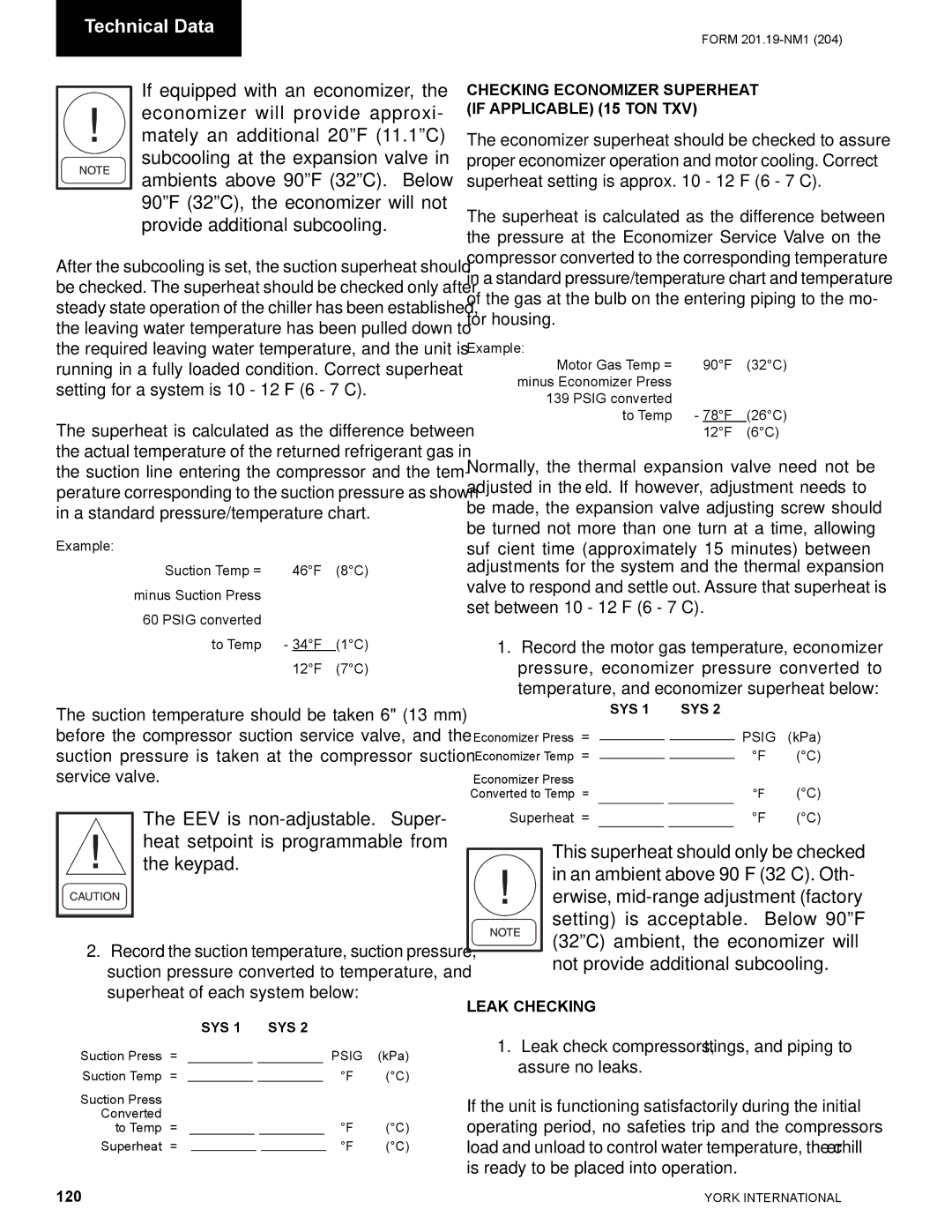
Technical Data
If equipped with an economizer, the economizer will provide approxi- mately an additional 20ºF (11.1ºC) subcooling at the expansion valve in ambients above 90ºF (32ºC). Below 90ºF (32ºC), the economizer will not provide additional subcooling.
After the subcooling is set, the suction superheat should be checked. The superheat should be checked only after steady state operation of the chiller has been established, the leaving water temperature has been pulled down to the required leaving water temperature, and the unit is running in a fully loaded condition. Correct superheat setting for a system is 10 - 12°F (6 - 7°C).
The superheat is calculated as the difference between the actual temperature of the returned refrigerant gas in the suction line entering the compressor and the tem- perature corresponding to the suction pressure as shown in a standard pressure/temperature chart.
Example:
Suction Temp = |
| 46°F | (8°C) |
minus Suction Press |
|
|
|
60 PSIG converted |
|
|
|
to Temp | - 34°F | (1°C) | |
|
| 12°F | (7°C) |
The suction temperature should be taken 6" (13 mm) before the compressor suction service valve, and the suction pressure is taken at the compressor suction service valve.
The EEV is
2.Record the suction temperature, suction pressure, suction pressure converted to temperature, and superheat of each system below:
|
|
|
| SYS 1 |
|
|
|
| SYS 2 |
| |||
Suction Press | = |
|
|
|
|
|
|
|
|
|
| PSIG | (kPa) |
Suction Temp | = |
|
|
|
|
|
|
|
|
|
| °F | (°C) |
Suction Press |
|
|
|
|
|
|
|
|
|
|
|
|
|
Converted | = |
|
|
|
|
|
|
|
|
|
| °F | (°C) |
to Temp |
|
|
|
|
|
|
|
|
|
| |||
Superheat | = |
|
|
|
|
|
|
|
|
|
| °F | (°C) |
FORM
CHECKING ECONOMIZER SUPERHEAT (IF APPLICABLE) (15 TON TXV)
The economizer superheat should be checked to assure proper economizer operation and motor cooling. Correct superheat setting is approx. 10 - 12°F (6 - 7°C).
The superheat is calculated as the difference between the pressure at the Economizer Service Valve on the compressor converted to the corresponding temperature in a standard pressure/temperature chart and temperature of the gas at the bulb on the entering piping to the mo- tor housing.
Example: |
|
|
|
Motor Gas Temp = |
| 90°F | (32°C) |
minus Economizer Press |
|
|
|
139 PSIG converted |
|
| (26°C) |
to Temp | - 78°F | ||
|
| 12°F | (6°C) |
Normally, the thermal expansion valve need not be adjusted in the field. If however, adjustment needs to be made, the expansion valve adjusting screw should be turned not more than one turn at a time, allowing
sufficient time (approximately 15 minutes) between adjustments for the system and the thermal expansion
valve to respond and settle out. Assure that superheat is set between 10 - 12°F (6 - 7°C).
1.Record the motor gas temperature, economizer pressure, economizer pressure converted to
temperature, and economizer superheat below:
|
|
| SYS 1 |
| SYS 2 |
| |
Economizer Press | = |
|
|
|
| PSIG | (kPa) |
|
|
|
| ||||
Economizer Temp = |
|
|
| °F | (°C) | ||
|
|
| |||||
Economizer Press |
|
|
|
|
|
| (°C) |
Converted to Temp | = |
|
|
|
| °F | |
Superheat = |
|
|
| °F | (°C) | ||
This superheat should only be checked in an ambient above 90°F (32°C). Oth- erwise,
LEAK CHECKING
1.Leak check compressors, fittings, and piping to assure no leaks.
If the unit is functioning satisfactorily during the initial operating period, no safeties trip and the compressors load and unload to control water temperature, the chiller is ready to be placed into operation.
120 | YORK INTERNATIONAL |
